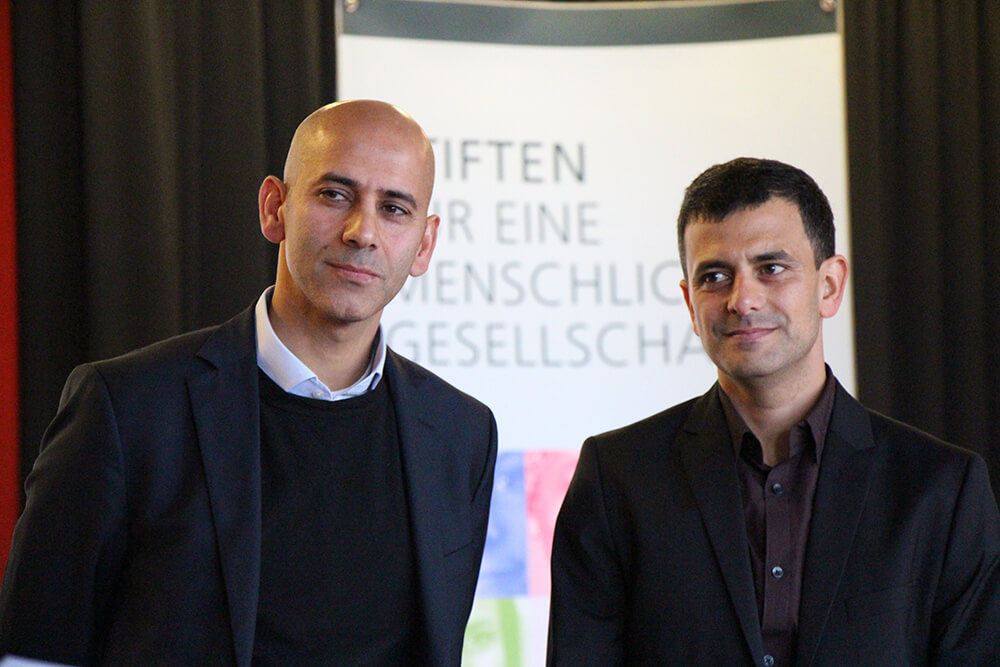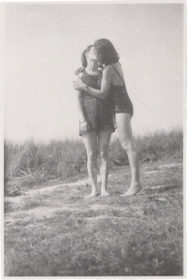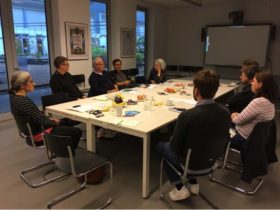An interview with Mohamed Ibrahim and Shemi Shabat about their tandem guided tour Jerusalem in Dialogue
Since April 2018, we’ve offered a tandem guided tour called Jerusalem in Dialogue (more about the tour) through our current temporary exhibition Welcome to Jerusalem (more about the exhibition). On each tour, two guides with their own personal relationships to Jerusalem speak from different perspectives about the city and the exhibition, which runs until 30 April 2019.
The format of a tandem tour emerged from a museum-guide training session (more about the training) that we conducted together with the Hochschule für Technik und Wirtschaft Berlin (HTW), a university of applied sciences. The German-Palestinian Mohamed Ibrahim and the Israeli Shemi Shabat contributed to its development and now oversee it together.

Mohamed Ibrahim and Shemi Shabat at the Flechtheim Prize ceremony of the Humanist Association of Germany (Humanistischen Verbands Deutschland) and the Humanist Foundation (Humanismus Stiftung); Humanistischer Verband Berlin-Brandenburg KdöR
Andy Simanowitz spoke to the two about the training, the concept of the tandem tour, and their relationship to Jerusalem.
Andy Simanowitz: To begin with, could you introduce yourselves and your work a bit?
Shemi Shabat: I’m Shemi. I was born and raised in Tel Aviv and I came to Berlin 11 years ago. At that time, a colleague asked me what I would think of developing workshops on the Palestine/Israel Middle-East conflict together with a Palestinian. At this point, we’ve been doing it for 10 years, going together to schools as a German-Palestinian and an Israeli to talk with students about the Middle East conflict. It’s now my second source of income; I’m also a consultant for the antidiscrimination network of the Turkish Federation in Berlin-Brandenburg.
Mohamed Ibrahim: I’m Mohamed, a German-Palestinian who has been living in Berlin for over 40 years. I was born in a refugee camp in Lebanon and I grew up in West Berlin. I studied politics here with a focus on international relations. My regional focus was the MENA region and the Middle-East conflict. My main occupation is development work at a federal implementing organization. As Shemi said, I’ve been doing these trainings with him for over 10 years.
(more…)
Sexual Diversity in the Collection of the Jewish Museum
On July 28th, Christopher Street Day will take place for the 40th time in Berlin. Like every year, it will feature demonstrations for the rights of gay, lesbian, bisexual, and transgender people, this time under the slogan My body—my identity—my life! (Link to this year’s CSD political points (in German)) As ever, its attendees publicly display and celebrate sexual diversity.
The collection of the Jewish Museum includes items related to people who would possibly identify as LGBTI today, but unfortunately they aren’t very visible. “Homosexuality” is a keyword in the museum database, but it is hardly used.

Felice Schragenheim and Elisabeth Wust on an excursion to the Havel River, just hours before Schragenheim’s arrest, Berlin, 21 August 1944; Jewish Museum Berlin, gift from Elisabeth Wust
Most of the items associated with this keyword come from the collection on Felice Schragenheim (1922–1945) and Elisabeth (Lilly) Wust (1913–2006). Erica Fischer’s 1994 book Aimée & Jaguar made their story known, and the 1999 film of the same name made it famous.
Photos and documents record their romantic relationship, including numerous love letters, some of them sealed with Felice’s kiss.
The two “marriage contracts” that the women signed with each other in 1943 are highly unusual. The 21-year-old Felice composed hers in the form of a decalogue with ten promises. The first line reads “I will always love you.” (more…)
A conference on anti-Semitism-critical adult education
My W. Michael Blumenthal Fellowship at the Jewish Museum Berlin on the topic Didactics of the Middle East Conflict ended in the beautiful month of May. During the past seventeen months, I have been intensively engaged with continuing education on this politically contentious and very emotionally charged topic, as well as with the question of what we as teachers of social studies or educators working outside of school systems can or should not do, in order to best approach the topic of the Near-East conflict with students (more at: www.jmberlin.de/fellow-rosa-fava-and-her-research).

Discussion of the participants; photo: Berivan Köroğlu
In retrospect, one of the highlights of the conference, which I organized in early April 2018 in order to bring together educators focusing on the Middle East conflict and Anti-Semitism with museum employees working in the areas of education and the Academy programs. Since the first conference in September 2017, the parameters had changed somewhat, since the opening of the Welcome to Jerusalem exhibition made the Middle East conflict an (even bigger) presence at the Jewish Museum. (more…)


